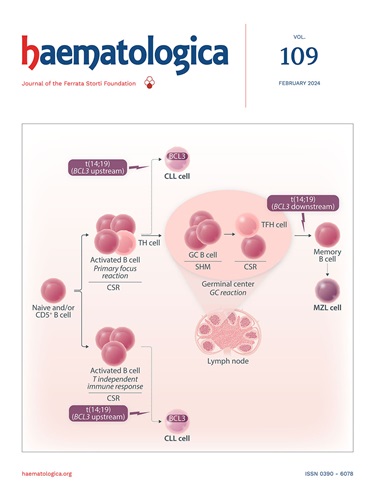NFATc1 and NFATc2 regulate glucocorticoid resistance in pediatric T-cell acute lymphoblastic leukemia through modulation of cholesterol biosynthesis and the WNT/β-catenin pathway.
IF 7.9
1区 医学
Q1 HEMATOLOGY
引用次数: 0
Abstract
The glucocorticoid (GC) resistance onset in pediatric T-cell Acute Lymphoblastic Leukemia (T-ALL) patients remains one of the biggest challenges in current cancer treatment. The mechanisms driving this resistance are still not fully understood, making it difficult to predict patient outcomes and to develop effective therapies. Our study uncovered critical insights into the biological processes underlying GC resistance, offering potential breakthroughs for future treatments. Building on our previous research on LCK kinase hyperactivation in GC-resistant T-ALL patients, we have now delved deeper into the LCK downstream NFAT transcription factor family's contribution to GC resistance. We discovered that, even at the time of diagnosis, GC resistant T-ALL patients exhibit an intrinsic low glucocorticoid receptor (GR) activity coupled with high NFATc1 and NFATc2 ones. This dysregulation creates a roadblock to effective GC therapy. Indeed, in the absence of either NFATc1 or NFATc2, the normal transcriptional activity of GR is restored, re-sensitizing the leukemia cells to dexamethasone treatment both in vitro and in vivo. This suggests that NFATc1 and NFATc2 are central to driving GC resistance, as they directly regulate crucial pathways like cholesterol biosynthesis and WNT/β-catenin signaling. The identification of NFAT transcription factors as key players in leukemia therapy resistance offers a promising target for future therapeutic strategies, potentially transforming the way we approach treatment for these challenging conditions or autoimmune disorders where glucocorticoids are a cornerstone of treatment.NFATc1和NFATc2通过调节胆固醇生物合成和WNT/β-catenin通路调节儿童t细胞急性淋巴细胞白血病的糖皮质激素抵抗。
儿童t细胞急性淋巴细胞白血病(T-ALL)患者的糖皮质激素(GC)耐药仍然是当前癌症治疗中最大的挑战之一。驱动这种耐药性的机制仍未完全了解,这使得很难预测患者的结果并开发有效的治疗方法。我们的研究揭示了GC耐药性背后的生物过程的关键见解,为未来的治疗提供了潜在的突破。基于我们之前对GC耐药T-ALL患者LCK激酶过度激活的研究,我们现在深入研究了LCK下游NFAT转录因子家族对GC耐药的贡献。我们发现,即使在诊断时,GC耐药T-ALL患者也表现出内在的低糖皮质激素受体(GR)活性,并伴有高NFATc1和NFATc2活性。这种失调造成了有效GC治疗的障碍。事实上,在缺乏NFATc1或NFATc2的情况下,GR的正常转录活性得以恢复,使白血病细胞在体内和体外对地塞米松治疗重新敏感。这表明NFATc1和NFATc2是驱动GC抗性的核心,因为它们直接调节胆固醇生物合成和WNT/β-catenin信号传导等关键途径。NFAT转录因子在白血病治疗耐药中的关键作用的鉴定为未来的治疗策略提供了一个有希望的靶点,有可能改变我们治疗这些具有挑战性的疾病或自身免疫性疾病的方式,其中糖皮质激素是治疗的基石。
本文章由计算机程序翻译,如有差异,请以英文原文为准。
求助全文
约1分钟内获得全文
求助全文
来源期刊

Haematologica
医学-血液学
CiteScore
14.10
自引率
2.00%
发文量
349
审稿时长
3-6 weeks
期刊介绍:
Haematologica is a journal that publishes articles within the broad field of hematology. It reports on novel findings in basic, clinical, and translational research.
Scope:
The scope of the journal includes reporting novel research results that:
Have a significant impact on understanding normal hematology or the development of hematological diseases.
Are likely to bring important changes to the diagnosis or treatment of hematological diseases.
 求助内容:
求助内容: 应助结果提醒方式:
应助结果提醒方式:


